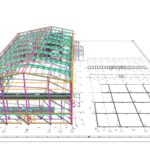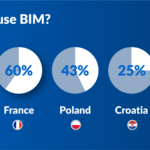Sector - Software & Technology
BIM Level 2: Where are we now?

I hosted an event in Newcastle recently called BIM: from Confused to Comfortable, and as part of the Q&A panel, I answered the question of when the BIM Level 2 mandate would be enforced fully. I forget my exact words, but in essence I said ‘never, but it doesn’t matter. We’ve crossed the chasm and the genie is out of the bottle. BIM is getting adopted whether you like it or not. And besides the Government are a touch busy at the moment so it’s over to us’.
Perhaps I was being a bit controversial to provoke a good debate out of the other panelists. But I’ve been thinking about this a lot since and an idea keeps coming back to me. Perhaps the BIM Level 2 mandate was possibly the greatest gambit the government ever played against the construction industry’s productivity troubles.
Those who play chess will know that a gambit is a ‘calculated gamble to gain an advantage’. But the result doesn’t need to be known, it’s not about definite outcomes, it’s about gaining control and minimising the variables. The Level 2 Mandate was offered up to the industry with the idea that adopting this way of working would be the only thing that Government clients could accept as of 2016, and it will be such a great way of working the private sector will follow, in turn.
Pawn to C4.
You don’t need to look far in the industry to see that there is still a lot of work coming out of the public purse that doesn’t yet have Level 2 as a firm requirement. In fact, there is a significant on-going debate about whether Level 2 is fully defined enough for clients to ask for it as a requirement, albeit with clarification. Perhaps the BIM Task Group knew all along some would take the pawn and others would play for position and leave it where it stood?
As much as the BIM mandate is not being enforced with an iron fist, I’ve come to think the gambit has been more than effective. When government’s attempt to redirect industries with a heavy hand it can cause contraction, stress failures and a drop in productivity. We already have enough skills and diversity issues without shooting ourselves in the foot with a forced and narrow innovation agenda.
The approach put the decisions, the response, the innovation and the strategy in the hands of the industry. Some who took the bait early have tried to weaponise the standards for business advantage, others have tried to influence the technology sector into supporting our digitisation evolution and others have simply worked hard to reach a level that they can call compliant, whatever that may look like to them.
Then there’s another crowd who accepted the need to digitise, but didn’t take the standards and processes of Level 2 or even Level 1 into their businesses, perhaps sensing the mandate may not be a blunt as it first appeared. They focussed their efforts on identified weak spots or opportunities. This led to a spike in uptake of digitised snagging, laser capture of site progress, a prop tech boom and the sporadic use of Virtual Reality and Augmented Reality to aid design and project marketing. These aren’t BIM to any specific level, but in the depths of the recession if anyone told you we’d have his much innovation inside a decade most people would have scoffed: because each project is unique, ten years is nothing in our game, we don’t do technology in construction, and probably some vaguely threatening comments about not trusting the cloud.
Others are yet to start, but they are starting to feel exposed by their competitors advances, and the Tender questions are getting scary. Just wait until the clients get really good at asking for what they want from BIM, the places to hide are disappearing, and not because we’re all doing Level 2, but because the genie is out of the bottle. It takes a rare client to see a 3D walkthrough of a data rich model and not ask ‘what else can we do with this?’ and ‘can I get data about my building out of this?’.
Much like a game of chess, the initial gambit gets less and less important as the game progresses, but its legacy defines so much of the game.
This is why I think we need to stop focusing so hard on which projects are and aren’t Level 2. What really matters is whether advantage has been brought to our projects and our clients by adopting BIM processes and technologies. If a client asks for BIM Level 2 as defined by PAS1192, then that’s what they should receive. If you are in a position of influence this is definitely where you should start, as you’ll have the backing of the standards, the shared knowledge of industry peers and the support of the UK BIM Alliance.
On the flip side, not delivering to Level 2 when asked to do so would erode their trust in us. If you sign up for this and spend the project trying to get out of it, you’re one of the bad guys. COBie is nothing to be scared of, and a lot of the Level 2 processes will align really well with the ISO compliance, you already have in place. I know real life and ISO aren’t always a mirror of each other, but every business is likely to have done a lot of the necessary thinking, it just needs a bit of a push on implementation BIM. If you need help with Level 2, ask, there are plenty out there, your local BIM Region is usually the right place to start, there are some truly excellent web resources out there too, and of course there are BIM consultants who are ready to work with you.
If the client doesn’t want to take the Level 2 route, this is fine, too, because there are so many more digital advantages we can bring to the table. Not doing Level 2 shouldn’t elicit any BIM snobbery as we’re all digitising together – in different way – addressing different problems at different paces, so this is a win, whichever way you look at it.
The question ‘please offer evidence of 3 previous BIM Level 2 projects’ in tenders and capability questionnaires is now proving too narrow: it’s not really showing the difference in quality and experience we need to build a great team for a project. It’s time for new questions about digitalisation, standardisation and, above all, the positive steps to bring the advantages of BIM to our projects and clients. Level 2 or not Level 2, isn’t the right question anymore.
The mandate gambit set the industry off on a number of innovation paths, some took the pawn, others didn’t, and others have realised they need to learn the rules of the game. But now when we look back in hindsight, delivering a mandate with room to wriggle and a dwindling threat of enforcement was perhaps the most positive trick ever played in our industry and, unlike chess, everyone who chooses to play the game can win. The only people who lose are those who put their heads in the sand.
By John Adams – BIM Strategy
If you would like to read more articles like this then please click here.
Related Articles
More Software & Technology News
- New laws will strengthen cyber defences for essential public services
4 Dec 25
UK government has introduced the Cyber Security and Resilience Bill to Parliament.
- £115M lost to cyberattacks
28 Nov 25
Small construction firms lose over £115 million to cyberattacks annually, making it the UK’s third-most
- COWI partners with University of Strathclyde to trial environmental DNA for sustainable infrastructure
18 Sep 25
COWI has partnered with the University of Strathclyde to trial the use of environmental DNA (eDNA)






